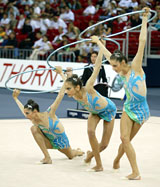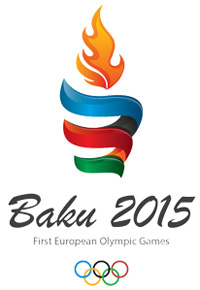Deutsch Englisch
16. Februar 2004
Moutier / SUI
Rhythmic Gymnastics
Interview with Egle Abruzzini
 |
|
Egle Abruzzini (ITA) |
Academies of Gymnastics
IT IS RHYTHMIC’S TURN!
Moutier / FIG. After the successful results achieved by the Academies of Artistic Gymnastics, the FIG is moving ahead by expanding the program to Rhythmic Gymnastics.
In an FIG-interview, Mrs. Egle Abruzzini (ITA), President of the FIG Technical Committee of Rhythmic Gymnastics, shared her point of view.
IT IS RHYTHMIC’S TURN!
Moutier / FIG. After the successful results achieved by the Academies of Artistic Gymnastics, the FIG is moving ahead by expanding the program to Rhythmic Gymnastics.
In an FIG-interview, Mrs. Egle Abruzzini (ITA), President of the FIG Technical Committee of Rhythmic Gymnastics, shared her point of view.
Mrs. Egle Abruzzini (ITA), President of the Technical Committee of Rhythmic Gymnastics, met with a group of experts at the International Federation’s headquarters to draw up the Academies’ framework for this discipline; among the participants, Mrs. Irina Vinner (RUS), Mrs. Nina Vitrichenko (UKR), Mrs. Daniela delle Chiaie (ITA), and Adrian Stan, the FIG coordinator of the program.
The goal of the FIG Academies is to educate the educators. This endeavor is important to Professor Bruno Grandi, President of the FIG, who is paying special attention to the qualifications and expertise of the coaches responsible for training gymnasts at every stage of their development. Candidates must successfully complete three educational levels, at the completion of which they will receive the FIG Coaching Brevet.
The program content of the FIG Academies includes all the topic areas essential to the training of athletes: technique, pedagogy, psychology, physiology, biomechanics, nutrition, and legal issues of sport, among others. These courses, periodically organized on all the continents, are taught by a group of well-known experts selected by the FIG.
Altogether academies will provide guidance and safety advice to coaches -- and for that matter to gymnasts as well -- who will be challenged to think with intelligence and good judgment about their careers in sports.
The goal of the FIG Academies is to educate the educators. This endeavor is important to Professor Bruno Grandi, President of the FIG, who is paying special attention to the qualifications and expertise of the coaches responsible for training gymnasts at every stage of their development. Candidates must successfully complete three educational levels, at the completion of which they will receive the FIG Coaching Brevet.
The program content of the FIG Academies includes all the topic areas essential to the training of athletes: technique, pedagogy, psychology, physiology, biomechanics, nutrition, and legal issues of sport, among others. These courses, periodically organized on all the continents, are taught by a group of well-known experts selected by the FIG.
Altogether academies will provide guidance and safety advice to coaches -- and for that matter to gymnasts as well -- who will be challenged to think with intelligence and good judgment about their careers in sports.
 |
|
Anna Bessonova (UKR) |
Do you think that the Academy program could be an impediment to spontaneous development?
On the contrary! Academies provide coaches with benchmarks and define the levels at which gymnasts are able to master difficulties and are ready to advance. At the end of every level, the gymnast should be able to assess his or her progress and find motivation for the next one. Too often, discouraged gymnasts give up everything, because they are unable to overcome high obstacles faced in the course of their apprenticeship.
The Academies’ program virtually places full mastery of the basic techniques around the ages of 16 or 17. It is therefore from that age on that the notions of aesthetics and choreography can be taught on a solid technical base. It is between the ages of 18 and 20 that expressivity in body movements will spring up from these young women to the great delight of the public.
A musician cannot be expected to improvise, if he does not grasp the technique of his instrument!
On the contrary! Academies provide coaches with benchmarks and define the levels at which gymnasts are able to master difficulties and are ready to advance. At the end of every level, the gymnast should be able to assess his or her progress and find motivation for the next one. Too often, discouraged gymnasts give up everything, because they are unable to overcome high obstacles faced in the course of their apprenticeship.
The Academies’ program virtually places full mastery of the basic techniques around the ages of 16 or 17. It is therefore from that age on that the notions of aesthetics and choreography can be taught on a solid technical base. It is between the ages of 18 and 20 that expressivity in body movements will spring up from these young women to the great delight of the public.
A musician cannot be expected to improvise, if he does not grasp the technique of his instrument!
Likewise, you should not expect the best execution of a beautiful element or combination from a gymnast who has not yet mastered a pivot. To build their future in sport, gymnasts need above all to have a good technical foundation. It is the role of the coaches, and therefore of the Academies, to remind them of this important principle. Necessary levels must be achieved and pitfalls recognized -- such as training overloads or requirements not compatible with a younger age. Academies also prompt the coaches to pay attention to the various evolutionary stages, because human bodies are fragile during their growth period and because it is dangerous to gamble with the health of an athlete.
Could the countries with no long tradition in rhythmic gymnastics be penalized because of their lack of experience in terms of coaching?
On the contrary, these nations have a significant advantage, since they can start at the grass roots with the right educational program from the very first course. Too often, it is the other way around! I even saw a choreographer conceive the most beautiful exercise at a very high level of difficulty. The gymnast visibly was not at this level, which forced the choreographer to gradually remove elements at every session.
In emerging countries, the Academies’ programs will guide the coaches through their development. In the example just given, we remove and go back. In the Academies’ programs, we add and go forward. Motivation is the whole difference, and this is what prompts me to encourage countries that may not have any ancestral experience to start at the very beginning.
On the contrary, these nations have a significant advantage, since they can start at the grass roots with the right educational program from the very first course. Too often, it is the other way around! I even saw a choreographer conceive the most beautiful exercise at a very high level of difficulty. The gymnast visibly was not at this level, which forced the choreographer to gradually remove elements at every session.
In emerging countries, the Academies’ programs will guide the coaches through their development. In the example just given, we remove and go back. In the Academies’ programs, we add and go forward. Motivation is the whole difference, and this is what prompts me to encourage countries that may not have any ancestral experience to start at the very beginning.
 |
|
Alina Kabaeva (RUS) |
How does the Code of Points fit within the framework of the Academies?
As I have said many times, the coach-athlete team too often approaches rhythmic with a fundamental mistake, a mistake that, in my own judgment, hinges on a rush to seek results. Even at the highest competition level, I often observe gifted gymnasts who will never achieve a faultless performance, because they are unable to master the basics. It is precisely the need to master the fundamental technique that will allow them to advance -- and to dream about a “perfect 30”!
Gymnasts want everything and immediately, which is a serious mistake! Sometimes I hear that the Code is to be blamed! I also hear criticism and the hostile reactions of the public when a score is announced. If the technique is not there, then it does not matter how original an exercise is or whether it is performed with genuine conviction!
As I have said many times, the coach-athlete team too often approaches rhythmic with a fundamental mistake, a mistake that, in my own judgment, hinges on a rush to seek results. Even at the highest competition level, I often observe gifted gymnasts who will never achieve a faultless performance, because they are unable to master the basics. It is precisely the need to master the fundamental technique that will allow them to advance -- and to dream about a “perfect 30”!
Gymnasts want everything and immediately, which is a serious mistake! Sometimes I hear that the Code is to be blamed! I also hear criticism and the hostile reactions of the public when a score is announced. If the technique is not there, then it does not matter how original an exercise is or whether it is performed with genuine conviction!
The Code is quite clear on this point: there are 30 points in the game. The technical component counts for 10. If a gymnast has not mastered the technical part, the game is lost even before it has started!
Academies move along the same lines as the Code and help “cash in” the 10 technical points. I should underscore that in rhythmic, we give points; we do not take them away!
Academies move along the same lines as the Code and help “cash in” the 10 technical points. I should underscore that in rhythmic, we give points; we do not take them away!
 |
|
The group of Italy |
How will the Academies’ program be developed for Rhythmic Gymnastics?
Phase I, which provides the technical and pedagogical foundation common to all the disciplines, already exists.
We are currently working on Phase II, which essentially focuses on defining the elements specific to the discipline, on learning the technique for handling apparatus and planning a schedule for progressive training. Rhythmic has its own peculiarities when it comes to body movements and the spatial handling of apparatus. These characteristics must first be mastered separately, before being integrated into a single movement. At this point, our approach is educational, so that coaches will learn how to avoid errors when they train gymnasts. Too many gifted gymnasts commit mistakes, because they have not fully grasped the technique.
Phase I, which provides the technical and pedagogical foundation common to all the disciplines, already exists.
We are currently working on Phase II, which essentially focuses on defining the elements specific to the discipline, on learning the technique for handling apparatus and planning a schedule for progressive training. Rhythmic has its own peculiarities when it comes to body movements and the spatial handling of apparatus. These characteristics must first be mastered separately, before being integrated into a single movement. At this point, our approach is educational, so that coaches will learn how to avoid errors when they train gymnasts. Too many gifted gymnasts commit mistakes, because they have not fully grasped the technique.
Finally, we bring in the musical component, a very important but too often neglected element. It is essential at this stage to learn how to blend thoroughly gesture and musical accompaniment.
Phase III will be completed in 2005-2006 and is the final stage leading to the FIG brevet, when all preliminaries have been fully understood and assimilated.
source: FIG press release
Phase III will be completed in 2005-2006 and is the final stage leading to the FIG brevet, when all preliminaries have been fully understood and assimilated.
source: FIG press release


 *... back to
*... back to














